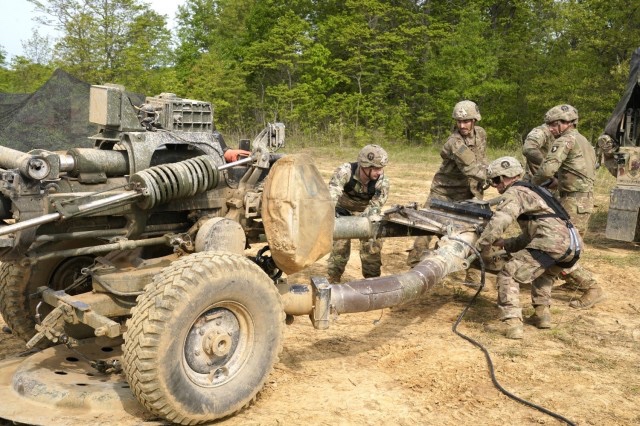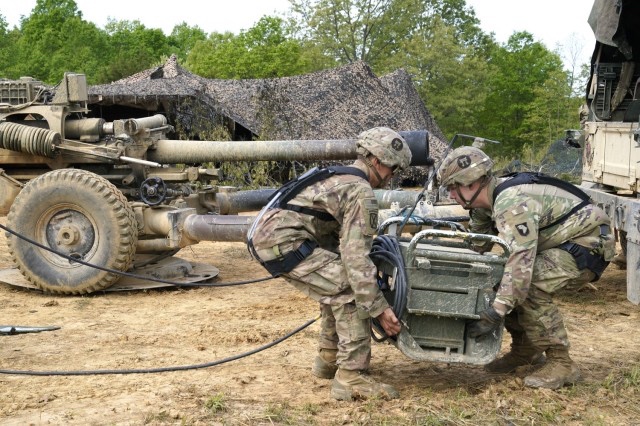
ABERDEEN PROVING GROUND, Md. — An unpowered exosuit designed to reduce the physical demands placed on Soldiers is one step closer to adoption after prototypes earned passing grades from more than 100 Soldiers at three Army posts.
According to the U.S. Army Public Health Center, low back injuries result in more than one million lost or limited duty days for Soldiers each year.
The Army’s Pathfinder program — led by a collaborative team of Soldiers from the 101st Airborne Division at Fort Campbell, Kentucky, and engineers at Vanderbilt University — brought about the design and testing of unique, exoskeleton prototypes to augment lifting capabilities and reduce back strain for sustainment and logistics operations.
The research and development of the soft, lightweight, unpowered exoskeleton, called the Soldier Assistive Bionic Exosuit for Resupply, or SABER, has moved from the Pathfinder team to the U.S. Army Combat Capabilities Development Command Soldier Center, or DEVCOM SC. The DEVCOM SC team is preparing the suit for manufacturing and robust field trial use by the Army.
The Pathfinder program is a congressional initiative to advance the Army Futures Command’s modernization goals and support the innovation of Soldier-inspired, research-based technologies like SABER. DEVCOM officials said they leverage the program to connect Soldiers with its global science and technology network, which ranges from fundamental research to advanced technology upgrades to already fielded equipment.
“By engaging Soldiers earlier in the research and development process, we are able to make them aware of emerging research and technologies that academia can provide to help meet their needs,” said Dr. Arwen DeCostanza, Pathfinder program manager. “Collaborative projects like this one, yield discoveries and future outcomes by capitalizing on the creativity of Soldiers, faculty, students, industry partners and the Army science and technology community.”

Working with Soldiers in the 101st Airborne Division, researchers at Vanderbilt designed SABER as a wearable device that is soft, lightweight and form fitting. This unmotorized device can be selectively engaged by the Soldier to assist lifting capabilities.
The exosuit design addresses needs identified by the Soldiers, such as aiding strenuous lifting tasks like ammunition resupply and reducing injury and fatigue, critical to readiness over sustained periods.
“We spent the first few months focused on interviewing, observing and spending time with Soldiers,” said Dr. Karl Zelik, associate professor of mechanical engineering, Vanderbilt University. “We didn’t try to create Iron Man — a complex, full-body, rigid, unrealistic suit. Instead, we started by deeply understanding Soldier needs to develop a lightweight, low-profile, non-powered wearable tool that helps provide much-needed assistance without slowing Soldiers down or interfering with other operational tasks.”
To develop the idea for this project, Vanderbilt engineers engaged Soldiers in frequent interviews, design sprints and field tests to identify critical problems hindering their daily duties in the field. Physical overexertion stood out as a problem in need of a rapid solution.
To address strength and endurance limitations associated with material handling and field artillery, Vanderbilt researchers, engineers, technology translation experts and other military partners — working alongside Soldiers — took an exoskeleton technology Vanderbilt had previously designed for commercial use and spent a year of iterative development and testing to transform it into the SABER system.
In designing the system, the team focused on extended use of the suit during critical tasks to address Soldier load and movement issues.
More than 100 Soldiers participated in testing of the exosuit at three different bases, reporting less back strain and greater endurance while wearing SABER prototypes.
“Over the course of the day, lifting 60-pound rounds you get worn out, especially after hours. It takes a toll on your body,” said Pfc. Dale Paulson, 101st Airborne Division. “Wearing the suit really helped a lot, especially with getting the rounds out of the back of the truck. It felt like it gave me an extra boost. I didn’t have to work as hard. I feel like it helped me move quicker.”

Biomechanical evaluations revealed that the three-pound suit reduced stress on Soldiers’ backs by more than 100 pounds while lifting. Additionally, most Soldiers increased their endurance by over 60 percent while wearing SABER.
An overwhelming 90 percent of Soldiers surveyed after operational field testing in May 2022 believed the exosuit increased their ability to perform job tasks, and all of them reported that they would be likely to wear it for their job if it were developed into a product and made available to them.
DEVCOM Army Research Laboratory, in cooperation with DEVCOM SC, is providing funding to HeroWear, a Nashville-based industrial exosuit manufacturer and to Vanderbilt University to iteratively design and fabricate dozens of pre-production units in late 2022, with the goal to ramp up to hundreds of units in 2023.
DEVCOM SC will also conduct field demonstrations for critical stakeholders, getting the technology in the hands of the 101st Soldiers and other units, while simultaneously working a broader transition path.
“We were extremely proud to be recognized by our fellow DEVCOM and AFC leads as partners of choice in understanding the technology, and how to introduce this game-changing capability to Soldiers,” said Dave Audet, chief, systems division, DEVCOM SC. “Our on-going DEVCOM Soldier Center exoskeleton program and collaboration with Vanderbilt made it possible to accelerate technology modification and a successful transition from [the Army Research Laboratory] to Soldier Center.”
The DEVCOM Army Research Laboratory manages the Pathfinder program in close partnership with the DEVCOM Armaments Center. Civil-Military Innovation Institute executes the Pathfinder program on site at each military location and facilitates the interactions between military and universities.
Universities in North Carolina, Tennessee, West Virginia and Montana are working with the 82nd and 101st Airborne Divisions — both under XVIII Airborne Corps — several Special Operations Groups and West Virginia and Montana National Guard units, to identify and rapidly solve Soldier challenges and accelerate the transition of those solutions into the Army.
By DEVCOM Public Affairs Office


Ever seen Elysium?
This was absolutely panned by 100% of the Soldiers at Campbell I personally know who tested it. It wasn’t helped by initially sky-high expectations, as the Soldiers were under the incorrect belief that they were testing powered exoskeletons. When they found out that they were wearing rock climbing harnesses with bungee cords, they were already in a bad mood.
Common complaints were chafing, snag hazards, and restricted range of movement. The general consensus is that these would be great for an Amazon warehouse worker, but doesn’t work well in a dynamic tactical environment.
US Military has alot of warehouses? Right tool for the right job?
Interesting were the two locations testing the same gear?
At last expo I visited there was a company show casing a suit… not bungee cords and climbing harness… each piece was 3d printed and sized specifically to the person… 10k$ I think was minimum cost…
Here is the challenges surrounding person borne systems… cost, weight and capability. Capability is a broad category… in my humble opinion we need to reduce the weight of everything we can.
I praise the continued effort to improve and strengthen the physical abilities of individual soldier.
This operational “test” is nothing more than pseudoscience. If you really want to see if this had measured benefit, place the soldiers in a lab and get VO2 Max, Heart Rate data, etc. and have them lift boxes or whatever for an hour.
Compare baseline without the suit to with the suit. Multiple groups before and after. A thousand soldier would make for n=1000 and we could see with their is a clinical or statistical difference.
While soldier feedback is imperative it first must be demonstrated that it works before you strap it on a soldier.